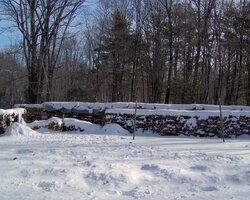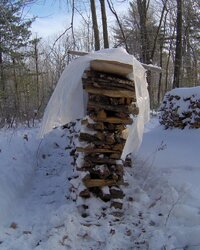Country Gentleman said:
I have four cords delivered in April adding to it with oak and hickory from my woods and stack it off the ground and uncovered to bake throughout the spring, summer and autumn ready for the winter. We have a large Regency insert.
I wheelbarrow a week's worth to an eight foot rack close to my house each weekend and cover it with a tarp and have the top of my main supply also covered from November however if there is wind and rain it will become exposed and get wet.
Do you lads recommend covering all year round or just closer to burning season? Anyone built a lean to for better coverage than a tarp?
Hey, there, Country. Welcome to the forum.
We here have very different opinions among us about covering firewood stacks. Some of us don't bother at all, some only cover what we plan to use that winter starting in the fall, some swear by keeping everything covered all the time.
It's really just a matter of convenience for your lifestyle. Rain and/or snow will only wet a fraction of an inch of the outside layer of the wood, and it dries off really fast either outdoors on the stack on a sunny day, even in winter, or faster indoors next to the stove-- like a couple hours. Personally, I hate wrestling with snow-covered tarps more than I do bringing in snow-covered wood and letting it dry inside. And as you point out, stuff gets wet anyway through the sides of the stacks, so I've never really seen much of a point to it.
I do have an enclosed attached woodshed on the back of my old farmhouse, though, and I usually transfer a good lot of my ready-to-burn stuff in there in the fall, and then use it as sort of a staging area when I have the time and inclination. Takes longer to dry out in there than it does in the house, a week or so, but it gets there.
The only thing you absolutely don't want to do is wrap your wood up with plastic because that holds in moisture. Other than that, as far as I can tell, it really doens't make enough difference to matter which way you do it.
If you use the search box on the site and just put in "cover," you'll find a whole lot of past threads full of arguments and disagreements and reasoning. But the important thing to keep in mind is that painful as it is to look out at your nice dry wood in a heavy rainstorm, it really doesn't penetrate into the wood far enough to be a big deal and it dries out very quickly. So you're not going to be damaging the burning quality of your wood if you don't cover it, it's just a matter of personal preference and the ability to plan ahead a few days.
A lean-to is good, as long as the opening isn't facing the prevailing wind direction. You might put something like that in the search box, too. A lot of people have posted pictures to show off their woodshed constructions, and I do remember seeing some pretty nice ones for small supplies right next to the house. But where you are, be careful how much you keep that close and for how long. You have termites down there. I'd guess a week's worth would be the max you'd want to keep so close, but other folks here can tell you more authoritatively than I, since we basically don't have a problem with them up here where I am.



